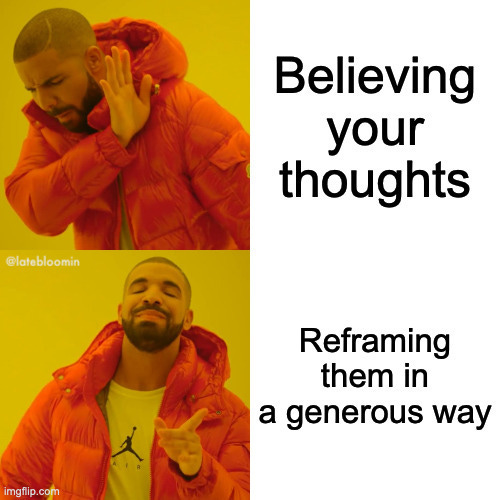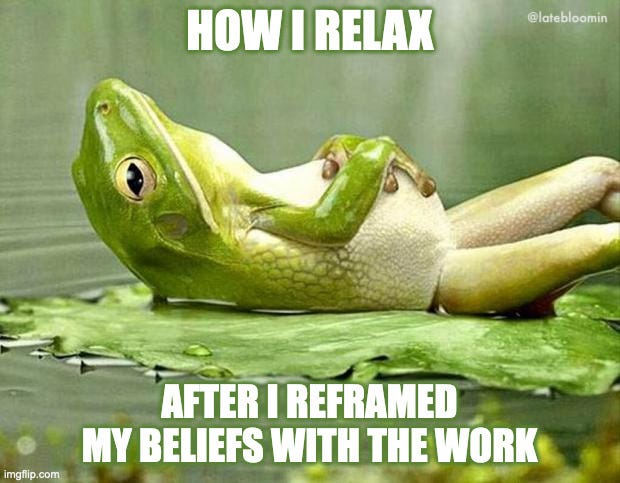stretch your mind - staying flexible with the work by byron katie
when our muscles feel tight, we know that stretching will help loosen them up. the same applies to our mental stiffness - sharing a tool to cultivate mental flexibility
This post continues the “cheat codes to life” series—or rather “cheat codes to a peaceful mind”—which began with meditation as an all-purpose weapon for mental health. While I can’t stress enough how profoundly meditation changed my life, other tools can be incredibly powerful for healing, especially when combined with meditation. What most of these tools share is their effectiveness at hacking our thoughts and reframing our life story (and specific situations) in a positive light. The ability to dismantle our beliefs, recognise when we’re engaging in negative self-talk, and distance ourselves from these thoughts, is imo crucial for lasting happiness.
flexibility creates freedom
One concept that life has repeatedly brought me back to is psychological flexibility. Being physically flexible allows our muscles and joints to move without restriction or pain, increasing our range of motion. Similarly, mental flexibility enables us to move through life with fewer constraints. This flexibility creates freedom: the freedom to choose what to engage with, to avoid being a victim of circumstances. The freedom to accept our past and move on, to adapt to life’s challenges. And the freedom to (re)write the storyline of our lives.
When our muscles feel tight, we know that stretching will help loosen them up. The same applies to our mental stiffness—we need practices to limber up our minds too. So I want to share a practice I’ve found helpful on this journey towards achieving a greater sense of ease. Just as we stretch our sore muscles during a yoga session, we can stretch our minds and alleviate our mental aches.
“The Work” by Byron Katie - loving what is:
I discovered that when I believed my thoughts, I suffered, but when I didn’t believe them, I didn’t suffer, and that this is true for every human being. Freedom is as simple as that. I found that suffering is optional.
- Byron Katie

One tool I’ve found immensely helpful for reframing my beliefs is “The Work” by Byron Katie. It’s a simple yet highly effective practice to question what you believe.
It may even feel too easy. We have this deep belief that change has to be a complicated and long-winded process, even though healing can sometimes be pretty straightforward. And trust me, "The Work" can be a real hack to reverse and overwrite one’s old beliefs. What I enjoy about the practice, is that it is empowering—emphasising our agency in what to believe and what not.
getting introduced to the work
I first heard of “The Work” through my father, who wanted to share this seemingly miraculous practice with his children and somewhat forced it upon us. By then, we had become accustomed to his recurring promo work. It felt like Groundhog Day when he once again intrusively advertised a new esoteric guru he had stumbled across. I’m sure he always had good intentions, trying to nudge us towards healing, and looking back, I’m trying to be grateful for it. But at that time, I was just sick of it.
judging the motto “suffering is optional”
I particularly judged Byron Katie’s acclaimed motto: ”suffering is optional”, which I felt was ignorant of the privileges of living in a Western country. I even found it presumptuous towards the suffering of many people who certainly didn’t choose their pain and aren’t to blame for their misfortune. I felt ashamed that my father would fall for this type of short-sighted ideology and—to make matters worse—now he wouldn’t shut up about it.
treat it like a buffet
Years later, I rediscovered the practice and was more open-minded and less judgmental towards it. That’s a general lesson I learned with wellbeing/mindfulness/spiritual practices: you shouldn’t take them too literally. They’re rather practical guidelines—inspiration towards healing—expanding one’s narrow perspective, but one shouldn’t follow them religiously. Treat it like a buffet—choose the practices and notions that work for you, and leave the stuff that doesn’t suit you for others. This way of approaching healing practices makes one less closed off towards new insights, staying open to various ways of healing.
here is how the practice works:
Start by identifying who or what upset you and why by recalling a specific situation. Then write about this experience and the emotions connected to it.
Next, isolate one upsetting thought and ask a set of four questions:
Example belief: “It’s too late, I’ve wasted my life”
1) Is this thought true? At first, I might still say yes because the belief is deeply rooted: I’ve indeed wasted my life, and since life is short, my time has run out. Too late to do anything about it. I have to accept my fate and that I’ve fucked up.
2) Can I absolutely know it’s true? Maybe now I might say no, because how can I be absolutely certain that it’s true? Isn’t it never truly too late? Who gets to decide, if I’ve wasted my life? Maybe I’ve learned important lessons along the way?
3) How do I react, what happens when I believe that thought? This part is crucial for the practice. Understanding how much this belief is holding me back, how much unnecessary suffering it’s causing.
=> When I believe this thought, I feel guilty, pressured, and paralyzed. I freeze and feel there’s no point in doing anything. I feel powerless, defeated, and hopeless. It creates tension, as if I’m carrying a heavy burden.
4) Who or what would I be without the thought? Now, visualising how much easier my life would be without the thought. How liberating would it be to let go of this belief ? What would it mean for you and your life? It may sound too simple, but trust me—visualising and verbalising the relief brings healing.
=> Without this thought, I would feel relieved and liberated, more at ease and hopeful for my future. I would feel less pressured and more proud of my achievements, more content with where I’m at in life. I would feel motivated to pursue my aspirations, not out of pressure but out of genuine desire.
Turnaround:
The final step is to turn that thought around and to contemplate how that new thought might be as true or truer: “It’s not too late, I haven’t waste my life”
1) Is this as true or truer?
2) Now, examine how this new belief would make you feel. Plus, you’ve also created an affirmation you can use daily or weekly to reinforce the new belief. Write it on a piece of paper and stick it on your wall or jot it down in your notebook.






